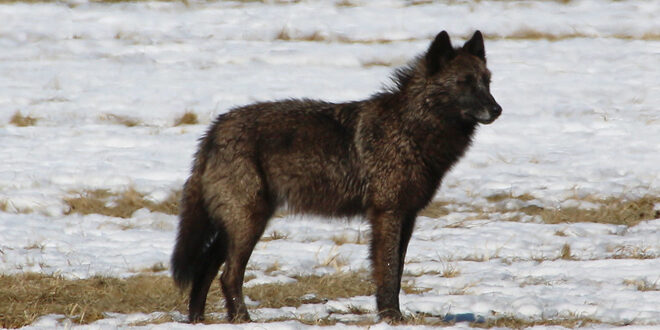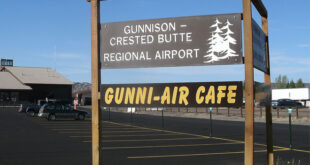The first meeting of its kind on the Western Slope
[ By Katherine Nettles ]There was no shortage of opinions about wolves last week, when more than 200 people turned out for the Colorado Parks and Wildlife (CPW) Wolf Restoration and Management public forum in Gunnison. The meeting was held on January 25 at Western Colorado University and attended by many officials, residents and ranching members of the Gunnison Valley and from neighboring regions, to listen to the independent commission members speak, to ask questions and to give their own statements. While attendees expressed a wide range of opinions on the reintroduction of the gray wolf to Colorado, the most common public commentary was focused on the program’s need to secure more funding to help livestock producers on the Western Slope prevent or mitigate potential conflicts between livestock and wolves, and to shore up reasonable compensation for predation when it does occur.
Mandated by a statewide vote in 2020, a plan must be finalized for Colorado’s wolf reintroduction by the end of 2023, and CPW has released a draft plan that is currently under a public comment period through February 22. The draft plan suggests establishing a range of up to 100 gray wolves on the state’s Western Slope, with about 10 animals per pack and 10 packs across the landscape. CPW anticipates approaching final draft approval in April or May.
Last week’s meeting in Gunnison was the second of the CPW independent stakeholder commission’s five meeting tour of the state. The first occurred in Colorado Springs in mid-January, where CPW reported about half the number of attendees.
“As the draft plan for reintroduction of gray wolves to Colorado undergoes the public comment period through February 22, it is critical that we hear from Coloradans and that our Colorado Parks and Wildlife Commission gets a chance to listen to the wants and desires of the public,” wrote CPW public information officer John Livingston in an e-mail to the Crested Butte News. “This was our first public wolf hearing west of the Continental Divide, where wolves will be reintroduced, and we were pleased that 52 members of the public along with seven members of the Stakeholder Advisory Group were able to speak and provide their valuable feedback.”
The meeting turned out a much larger crowd than expected by CPW, and more chairs were brought in to fill the WCU Ballroom. An additional viewing room was added with live streaming when the ballroom continued to overflow with attendees.
The meeting began with several short presentations including one by Eric Odell, species conservation manager with CPW, who described how the wolf reintroduction plan takes an impact-based management approach. “This recognizes that there are both positive and negative impacts to having wolves on the landscape,” he said.
Odell described how the management process aims to establish a self-sustaining population of wolves. “Management is not synonymous with lethal tools,” he said, and the plan does not allow wolf hunting. Negative impacts would be managed using both lethal and non-lethal tools, including education, conflict minimization, lethal taking of wolves and compensation to livestock producers.
Odell said the vast majority of wolves are not expected to be in any conflict with livestock or people, and reported that based on the experiences of states in the Northern Rockies, 17% or one in five packs have been involved in some sort of conflicts on an annual basis. He anticipated that the targeted lethal management has the potential to be the most contentious issue and will be used after all other options have been unsuccessful. He said the way that depredating wolves are handled “may influence the long-term persistence and social tolerance for wolves, as those wolves that aren’t implicated in any depredation are likely to be better tolerated.”
Odell said that certainly, “Where wolves and livestock share the landscape there will be conflict.”
Luke Hoffman, CPW game damage program manager, then presented the CPW draft conflict minimization and compensation program. He reviewed that CPW will provide livestock owners with “temporary conflict minimization materials, including fladry (flagged ropes), fox lights, cracker shells, propane cannons, and it will also provide conflict minimization “outreach/training” through a CPW wolf conflict coordinator. Additionally, CPW will pay “fair compensation to owners of livestock for any losses of livestock caused by gray wolves.”
Conflict minimization techniques are not required for compensation but are encouraged and incentivized. Depredation confirmations will be made by CPW based on a “more likely than not” philosophy and compensate up to 100% of fair market value with a maximum of $8,000 per head of livestock injured or killed, and the program can provide compensation for direct or indirect losses. Veterinarian costs for livestock or guard/herding animals would also be compensated up to $8,000. Up to five heads per each confirmed depredation would be compensated, and up to seven if conflict minimization tools have been used. Beyond depredation, itemized production losses, such as stressed livestock performing below standards, can be claimed if baseline weights for the past three years are provided.
Public comments were then taken for close to two hours. Some speakers asked for more careful planning; others asked for higher numbers (the plan calls for 200) before wolves could be delisted, and removal of stage four in which wolves can eventually be hunted under certain circumstances; and many ranchers from the Gunnison Valley and beyond spoke of their concerns with the reintroduction impacts to their livelihoods and heritage.
Shane Cox spoke as a board representative from the Gunnison County Farm Bureau, asserting that the voter mandate was an impractical emotional act. “We exist at the whim of the market. Our costs are so much,” he said, and the costs to mitigate or try to keep wolves away from livestock would detract from their bottom line. Cox said the reintroduction program will impact overall production for all farms. “Everybody that produces food for the nation…all those things are impacted.”
Jason Peterson spoke representing Gunnison County Stockgrowers Association. Peterson said profit margins are small to begin with, and any alterations to current operations would come closer to putting them out of business. “We don’t do this for the profits. We do it for our heritage, for our kids down the road. To care for livestock, to care for landscapes. To help CPW manage the private ground and the public ground that all of our game animals habitat on. We’re nervous about extra costs with the wolf program,” he said. He noted that Colorado is different from its northern neighbors, with a much higher human population and recreation “through the roof,” adding that conflicts will occur, and funding needs to be available to handle that.
Doug Washburn of Spann Ranches commended CPW and the commission for doing “the best they can do with the limited resources that they have.” He echoed concerns about the program’s funding. “We’re having these big in-depth conversations about what we’re going to do, and there’s no money to do anything.” He said he views it as a cart before the horse situation. “I understand that it was mandated by voters, but you’ve really got to take a little bit more time…and get some money in front of us so that we can have a conversation about what we’re going to do with it.”
Washburn also commented on lethal taking, and said he hopes CPW has every tool in the toolbox. “The number of people, the number of recreationalists that are here really makes their jobs that much harder,” he said of the program. He said he hopes CPW can be as effective as they have been in the past making Colorado diverse in wildlife
Matt Reed, public lands director for High Country Conservation Advocates (HCCA), said restoration must be sustainable. He recommended adding geographic components to the thresholds for delisting be instated. He suggested no future wolf hunting and said wolf predation predictions on the endangered Gunnison sage grouse may be overstated. The wolf would likely reduce coyote numbers, he said. “Nevertheless, please manage the wolf/sage grouse relationship.”
Gunnison Valley veterinarian Seth Nienhueser spoke in favor of producers being able to manage wolves independently if funding fails in the future, to preserve quality of life for wolves and livestock alike.
Dave Todd said he operates a ranch in northern Gunnison County, “And from what I can tell that’s where a bunch of them are going to be released.” He said much of the cattle grazing area cannot be accessed except by horse, and could take days to discover a cow killed by wolves. He said he also has four small children who help on the ranch, whose safety would be a concern. He said he has seen what damage coyotes can do and that wolves will be much worse. “There’s a reason we don’t have wolves in Colorado,” he concluded, and quoted “those who do not pay attention to history are doomed to repeat it.”
Livingston reflected after the meeting that “Coloradans are engaging respectfully and passionately at a historic time for Colorado wildlife, and we want to thank everyone who has taken the time to read the draft plan and provide comments that will help shape how wolves and all wildlife are managed in the state.”
The next public meeting is scheduled on February 7 in Rifle, followed by a virtual evening meeting on February 16 and a final meeting in Denver on February 22. More information on the plan can be found at cpw.state.co.us
 The Crested Butte News Serving the Gunnison Valley since 1999
The Crested Butte News Serving the Gunnison Valley since 1999


